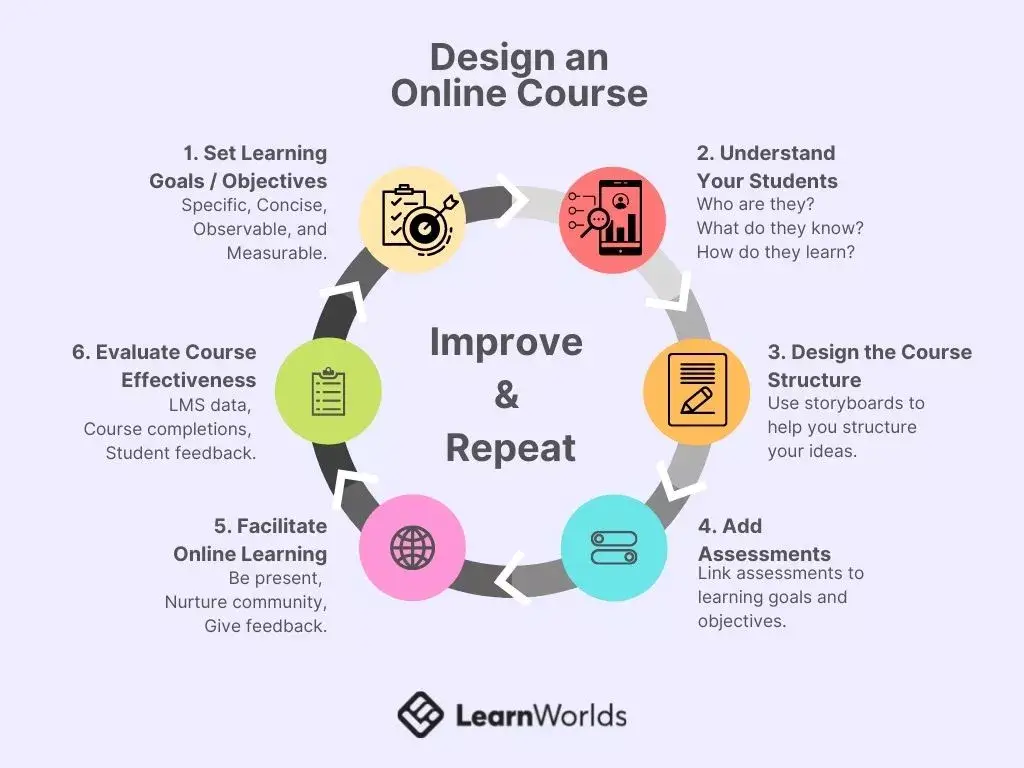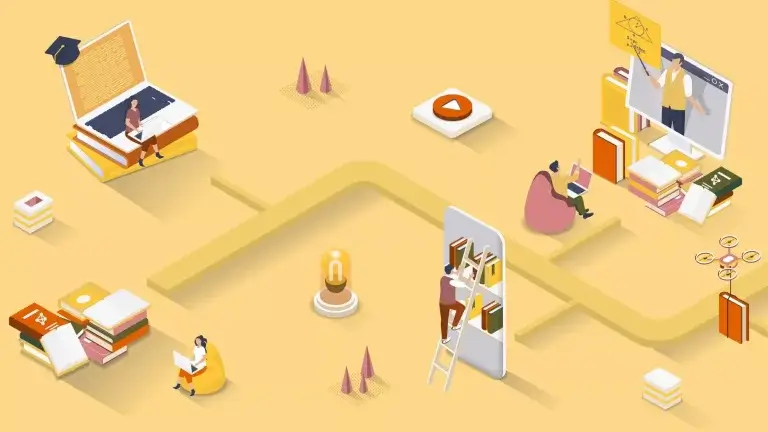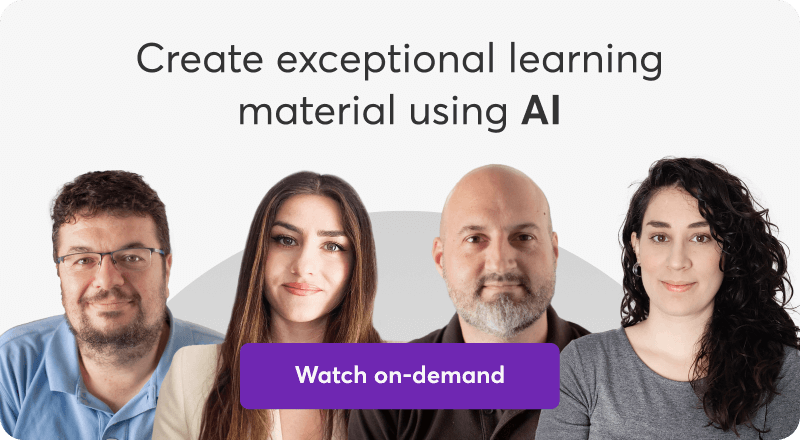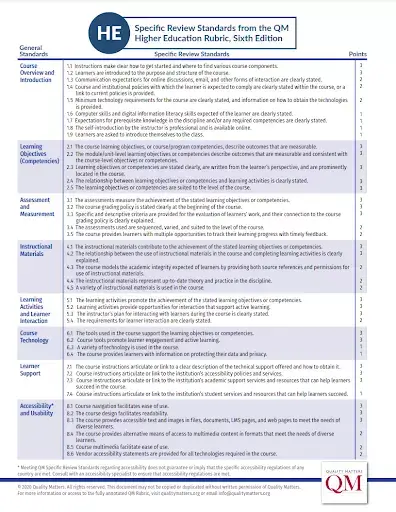Table of Contents
Teaching an online class follows similar principles as teaching in a physical classroom, but it comes with its own challenges. Whereas in a class, a teacher can engage with students, improvise on the spot and get direct feedback, in an online environment, it becomes much harder to keep students engaged.
For this reason, online course design has become even more important. Even more so in an asynchronous environment, where instructors have to design the curriculum and course material ahead of time.
Instructional design principles still work while developing an online course, but you have to try harder to understand your students, their needs and the challenges they face.

Table of contents
Developing an Online Course Structure & Curriculum
The first step of the design process is to understand the needs of the students. Writing down the learning goals and outcomes as well as constraints is critical to course design.
Here are a few questions to help you develop learning goals and identify constraints:
Once you have a clear idea of these factors, you can begin to map out your course curriculum and decide which learning content and activities will be most effective in engaging your students.
This might include things like:
In the end, you will end up with a layout of a course. A storyboard can help you collect and structure the curriculum while taking notes on the type of learning content you need to create.
Check out our course design templates to get ideas on content and course structures:
Best Practices to Plan the Course Content
Writing course content is simple when you have a plan for it. Knowing who you are writing for and having a well-defined structure will help you build the content faster and improve the quality of your online course.
Here is what you need to do while planning your course:
Approach content design systematically
To create effective elearning content, it is important to approach content design systematically. This involves creating a detailed curriculum or storyboard that outlines the learning activities you will need to develop.
With this plan in place, you can then begin to carefully plan the various components of your elearning course, including the content itself, assessment activities, and any other relevant supporting materials or infrastructure.
By taking a structured, methodical approach to elearning content design, you can ensure that your lessons are engaging and effective for learners of all levels.
Additionally, a well-designed elearning course can be easily migrated to a learning management system (LMS).It will also be easier to track and analyze student progress over time.
Keeping these key considerations in mind will help ensure that your course is truly a truly valuable resource for your students.
Organize content
In any course, it is important to consider -how the learning content is organized. When course development is approached carefully, it can lead to student success.
A well-organized course will have a clear structure and flow, making it easy for students to follow along and understand the material.
Meet learner needs
Understand your students’ demographics and specific needs.
– Who are they?
– Do they have any prior knowledge?
– What is their educational level?
– How busy are they?
You can include a variety of instructional materials to ensure learners can learn in different ways that work for them.
Make sure that by the time students finish your course, they will have gained the knowledge and fulfilled the learning goals you have already set for them.
Encourage student interactions and community
Collaborative projects, discussion forums, or peer review activities are necessary for students to interact with each other and the course content in different ways.
Learning does not happen in a vacuum, but is rather a social activity. Encouraging interactions and building a learning community will increase student engagement, retention and learning.
✨ Supercharge Your Course Creation with AI!
Want to create exceptional learning experiences faster and smarter? Discover how you can harness the power of AI in instructional design. Watch our on-demand webinar to learn tips, tricks, and best practices from industry experts.
How to Assess Students
Student assessment is a crucial part of the learning experience and will help you evaluate whether the learning objectives have been met.
You can build assessments in-between other course activities or as final examinations of the course.
Assessment can also lead to certification, self-evaluation, learning or a feeling of achievement. Read our assessment best practices article to learn more!
How to Evaluate Course Effectiveness
Quality matters, and whether you are teaching a synchronous or asynchronous course, you want to evaluate the course’s effectiveness.
This can happen in a number of ways:
Another way to evaluate the quality of your course by yourself is using the Quality Standards rubric below:
Act on the Feedback
A course creator’s work is never done. Based on the feedback you receive and the quality assessment results, which you should revisit regularly, you will keep improving your course as you go.
There are many actions you can take to improve your course. For example, you might want to consider:
Be sure to listen to your students and evaluate the results against the stated learning goals, and you will be a better instructor for doing so 🙂
Tips to Facilitate Online Learning
Online learning requires a different kind of facilitation and might be even more important to show a strong instructor presence while teaching online.
Instructor-student interactions, personal or mass communication, and the sense of availability play an essential role in keeping students engaged.
Timely respond and give feedback
Successful instructors check in to the course at least once a day. They begin their workday by reading student messages or responding to student discussion posts in the morning, and then check in again later in the evening and sometimes during the day.
Timely responses and feedback are critical.
Top instructors respond to student messages within 24 or 48 h, and grade student assignments within 48 h. Post (or email) weekly or even daily announcements with reminders of what is expected of students that week or the content of the new learning activities.
Students need to feel supported; they need to understand that they do indeed have a mentor by their side.
Be available and present
Make sure that your presence in the course is strong. For example, show yourself in videos or other multimedia formats so that students can hear your voice and see your body language.
With that warm presence and empathy, let the student know that you are there. Learn more about the instructor’s presence from the instructional video styles guide.
P.S.: Smaller groups can help with instructor interactions. This is why more and more people choose to take on cohort-based courses, where smaller groups create a community and allow the instructor to be more present.
How to Design Online Courses for Specific Purposes
When it comes to course development, one size does not fit all. The design of an online course should be tailored to the subject matter and the specific learning objectives. With that in mind, here are a few niches that require a different instructional design approach:
How to Design a Training Course
Training courses are tightly knit to their learning objectives. A training course aims to teach a specific soft or hard skill or competency, and it aligns with an organization’s goals. These are the north stars of developing the structure, syllabus and training material.
Training might also have additional requirements like CPE credits for continuing education or corporate training for a specific job. In both cases, it might come with specific learning material that you need to ‘deliver, report on, track and assess.
Be sure to familiarize yourself with the goals and requirements before moving forward with a training course.
How to Design a Coaching Course
Coaching is a more open-ended approach, where you are guiding a person towards a solution that works for them.
Coaching requires more self-reflection and interaction with the instructor/coach than any other type of course. Assessments are usually not graded but opportunities for feedback.
When designing a coaching course, you need to think whether your subject is suited for self-paced learning or whether you will be adding a lot of live interactions like 1-on-1 sessions, webinars, workshops and group coaching sessions.
In coaching, it’s all about the individual and their personal goals over your predetermined goals. Remember this when designing a coaching course!
Read more on online coaching:
How to Design a STEM Course
In STEM, you need to nurture your students’ problem solving skills. For this, you need to teach them the subjects and then present them with problems to practise on.
Usual methods of teaching STEM online include:
A study on teaching statistics showed that case studies were slightly more effective compared to other methods, although all the above methods showed good results.
In STEM, it is very important for the instructor to be aware of the knowledge level of their students, their background and the difficulty of the course they are teaching. There are major differences between STEM courses for elementary, high school and higher education students, as well as different engagement methods.
Younger students might require more instructor interactions, while older students should be able to study and solve more complex problems by themselves.
E-Learning Course Design is the Future
Online learning environments are the future of education. While physical classes, PowerPoint and traditional education will not disappear, more and more of our learning activities will move online.
The number of students learning in a blended educational environment, with both an in-person component and self-paced or online resources, will increase.
Learning how to design effective online courses or blended learning experience is important for every educator.
And, to do so, you will need an LMS. The best choice for individual instructors and small and medium businesses is a flexible, modern LMS like LearnWorlds. Give LearnWorlds a try with its 30-days trial to design awesome learning experiences today:
Frequently Asked Questions (FAQs) on Course Design
How do you design a course?
The first step in designing a course is understanding your subject and your students. Then, write down the learning objectives of the course. After that, you will need to write down the structure of the course. Storyboards are a great way to structure your course.
How do you assess students?
Depending on the subject or the activity, you can assess your students differently.
Structured quizzes or exam-style assessments work well for informational content. They are an effective way to measure whether the students understood and memorized the content.
Open-ended questions or assignments help assess critical thinking skills and how well learners have understood the subject.
Self-assessment works better in coaching or non-structured learning, where the students set the goals themselves.
Evaluation forms can also work as a kind of self-assessment or reflection for students.
How do you evaluate the success of a course?
Instructors can evaluate whether a course has been successful in a variety of ways:
How to accommodate different learning styles?
There is a myth of the auditory, visual or kinesthetic learner. The reality is that we are all a combination of those. The best way to accommodate different learning styles is to offer a variety of different learning activities which repeat themselves in different ways.
For example, offer an instructor-led video to explain a topic and a reading resource along with it, followed up by a quiz or assignment to test the learner’s knowledge of the topic.
This way, you cover the topic in different ways, allow for repetition and enable practical application.
Nick Malekos is a Senior Digital Marketer in LearnWorlds. He is a results based and well-rounded Digital Marketer with years of experience in the education industry, writer and digital literacy trainer.




